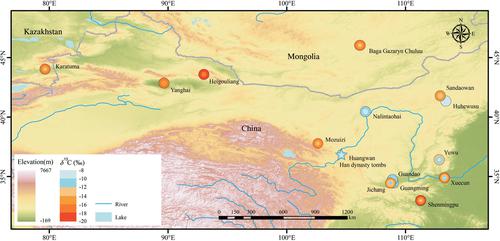当前位置:
X-MOL 学术
›
Acta Geol. Sinica Engl. Ed.
›
论文详情
Our official English website, www.x-mol.net, welcomes your
feedback! (Note: you will need to create a separate account there.)
The Integration of Farmers and Nomads: Archaeological Evidence for the Human Subsistence Strategy in Northwestern China during the Han Dynasty
Acta Geologica Sinica-English Edition ( IF 3.5 ) Pub Date : 2020-06-26 , DOI: 10.1111/1755-6724.14536 Xin LI 1, 2 , Minxia LU 1 , Yifu CUI 1 , Ruiliang LIU 3 , Minmin MA 1
Acta Geologica Sinica-English Edition ( IF 3.5 ) Pub Date : 2020-06-26 , DOI: 10.1111/1755-6724.14536 Xin LI 1, 2 , Minxia LU 1 , Yifu CUI 1 , Ruiliang LIU 3 , Minmin MA 1
Affiliation

|
The integration of farmers and nomads in northwestern China during the Han Dynasty (206 BCE ~ 220 CE) provides a crucial opportunity to reconstruct the material exchanges, formation and development of the Silk Road in antiquity. The subsistence strategy is arguably an effective proxy for the integration of various groups of people (e.g. farmers and nomads). In this paper, we have reported new stable isotope data from the Huangwan tombs dated to the Han dynasty in middle Gansu, which was the key juncture between the Han and Xiongnu empire, in order to fill the gap and further understand the substance strategies employed by the local people. According to the results of plant remains and stable isotopic data, millet farming, the typical agricultural activities for the Han Chinese in the Central Plains, was also the primary lifestyle for the Huangwan people in the mid Gansu. More importantly, this shows fundamentally remarkable difference from the agricultural practices in the Bronze Age Gansu Corridor, which were based on a variety of crops, including wheat, barley and millet. This major shift in the subsistence production at Huangwan can be correlated to a wider historical background in which the Han empire showed increasing political and military presence in the Gansu Corridor, indicating that local indigenous nomads followed the lifestyle of Han Chinese (e.g., millet farming), and/or the Han immigrates maintained millet farming.
中文翻译:

农民与游牧民族的融合:汉代西北人类生存战略的考古证据
汉代(公元前206年〜公元220年)西北地区农牧民的融合为重建古代丝绸之路的物质交流,形成和发展提供了重要的机会。生计战略可以说是各种人(如农民和游牧民族)融合的有效代表。在本文中,我们报道了新的稳定同位素数据,该数据来自甘肃中部汉代的黄湾陵墓,这是汉代与匈奴帝国之间的关键关头,目的是填补这一空白并进一步了解其所采用的实质策略。当地人。根据植物残渣的结果和稳定的同位素数据,小米耕作是中原汉族典型的农业活动,也是甘肃中部黄湾人的主要生活方式。更重要的是,这与青铜时代的甘肃走廊的农业实践有着根本的显着差异,后者基于多种作物,包括小麦,大麦和粟。黄湾地区生计生产的这种重大变化可能与更广泛的历史背景有关,在这个历史背景下,汉帝国在甘肃走廊显示出越来越多的政治和军事存在,这表明当地的土著游牧民族遵循了汉族的生活方式(例如粟农)和/或汉族移民维持小米种植。大麦和小米。黄湾地区生计生产的这种重大变化可能与更广泛的历史背景有关,在这个历史背景下,汉帝国在甘肃走廊显示出越来越多的政治和军事存在,这表明当地的土著游牧民族遵循了汉族的生活方式(例如粟农)和/或汉族移民维持小米种植。大麦和小米。黄湾地区生计生产的这一重大变化可能与更广泛的历史背景有关,在这个历史背景下,汉帝国在甘肃走廊显示出越来越多的政治和军事存在,这表明当地的土著游牧民族遵循了汉族的生活方式(例如粟农)和/或汉族移民维持小米种植。
更新日期:2020-06-26
中文翻译:

农民与游牧民族的融合:汉代西北人类生存战略的考古证据
汉代(公元前206年〜公元220年)西北地区农牧民的融合为重建古代丝绸之路的物质交流,形成和发展提供了重要的机会。生计战略可以说是各种人(如农民和游牧民族)融合的有效代表。在本文中,我们报道了新的稳定同位素数据,该数据来自甘肃中部汉代的黄湾陵墓,这是汉代与匈奴帝国之间的关键关头,目的是填补这一空白并进一步了解其所采用的实质策略。当地人。根据植物残渣的结果和稳定的同位素数据,小米耕作是中原汉族典型的农业活动,也是甘肃中部黄湾人的主要生活方式。更重要的是,这与青铜时代的甘肃走廊的农业实践有着根本的显着差异,后者基于多种作物,包括小麦,大麦和粟。黄湾地区生计生产的这种重大变化可能与更广泛的历史背景有关,在这个历史背景下,汉帝国在甘肃走廊显示出越来越多的政治和军事存在,这表明当地的土著游牧民族遵循了汉族的生活方式(例如粟农)和/或汉族移民维持小米种植。大麦和小米。黄湾地区生计生产的这种重大变化可能与更广泛的历史背景有关,在这个历史背景下,汉帝国在甘肃走廊显示出越来越多的政治和军事存在,这表明当地的土著游牧民族遵循了汉族的生活方式(例如粟农)和/或汉族移民维持小米种植。大麦和小米。黄湾地区生计生产的这一重大变化可能与更广泛的历史背景有关,在这个历史背景下,汉帝国在甘肃走廊显示出越来越多的政治和军事存在,这表明当地的土著游牧民族遵循了汉族的生活方式(例如粟农)和/或汉族移民维持小米种植。









































 京公网安备 11010802027423号
京公网安备 11010802027423号